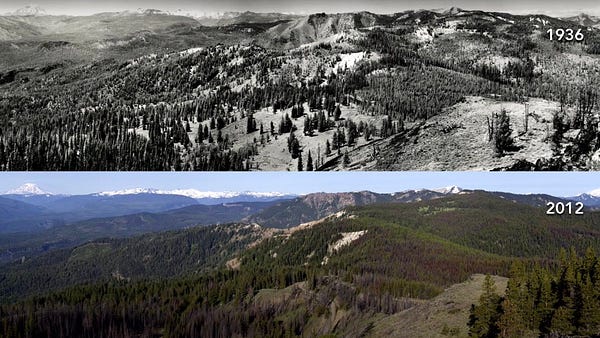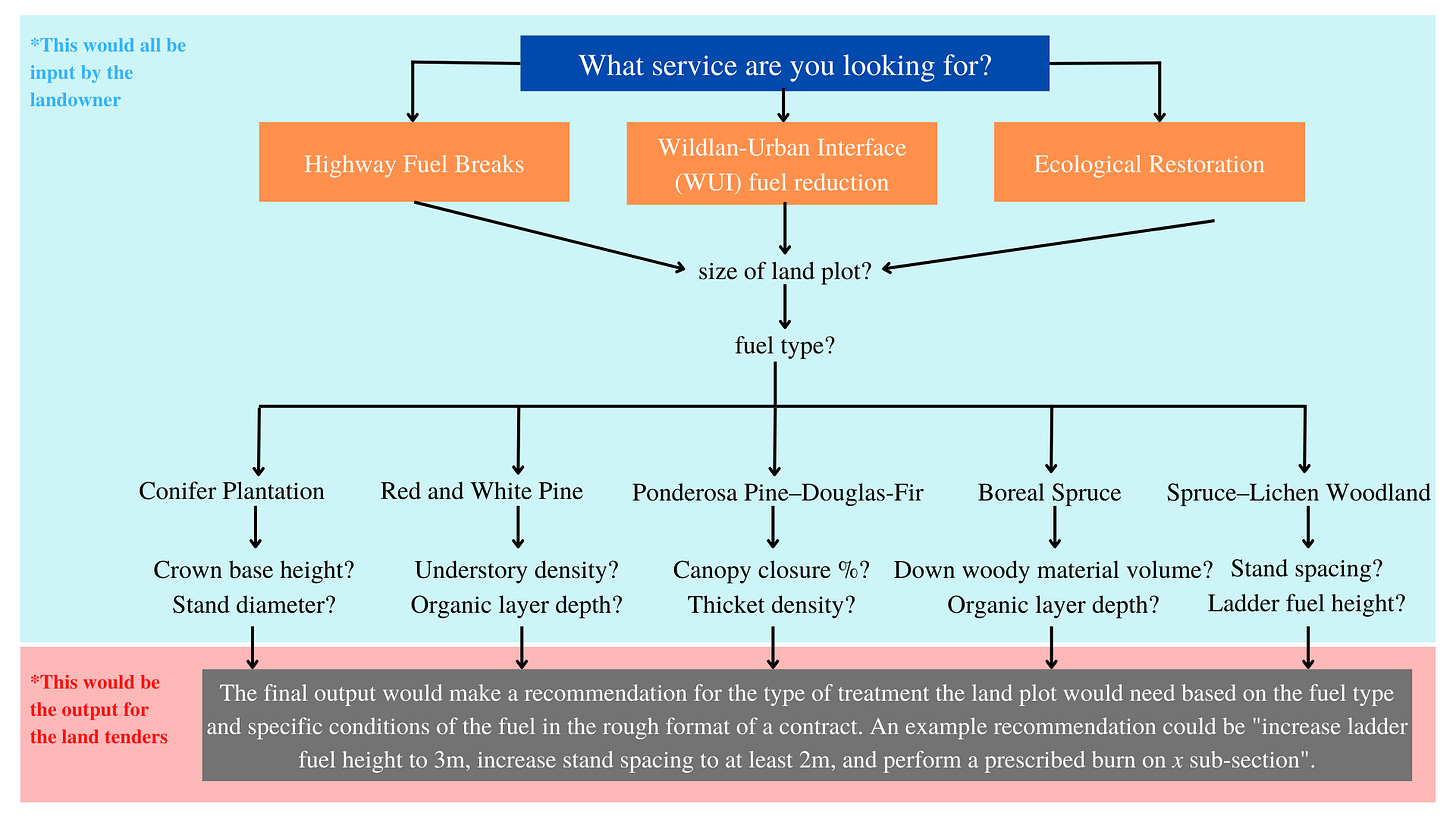Ember Bazaar Progress Update #1
Since pivoting away from Project Firefly due to unforeseen circumstances, we have been hard at work building our new idea and are excited to share our progress so far.
Hello! Welcome to the very first Ember Bazaar Update. If you’re recieving this, you either personally know either Valkyrie Holmes or Jesse Pound, and/or you have supported our work in the past. As you may remember, we spent over a year working on Project Firefly, which aimed to use vortex canons attached to drones to more effectively suppress wildfires. Unfortunately, we recently had to undergo a complete pivot and are now working on something entirely different. Though we regret never seeing Project Firefly through, we are very excited about our new idea and have created this bi-weekly newsletter to keep you updated on our progress as we build it out
So, what is this new idea? Introducing: Ember Bazaar. It’s a marketplace for landowners and land tending companies to post and accept jobs that involve tending forests and removing debris from private lands. Due to over a century of aggressive wildfire fighting, today’s forests are overgrown and in desperate need of these types of jobs. Yet, the rate at which they are currently being done is far too slow, and is leaving millions of people in both Canada and the US at risk of losing their homes and possibly their lives to massive wildfires. One reason for this is because much of the land which requires tending is located on small, private plots of land and many of the owners of this land do not have the know-how or budget to tend to it.


The last few weeks have been dedicated to market research and developing the system outline. We’ve reached out to 200+ contracting agencies, forestry departments, individual contractors, state departments, and federal land supervisors as well as private landtenders and private landowners. We’re currently planning and building our webapp prototype and have been building in public both on Twitter and Pioneer. Below, we’ve summarized our main takeaways from the research we’ve done so far, organized under the categories of market analysis, case studies, funding system, and contract automation. Feedback or further ideas are welcomed!
Market Analysis
Currently, we believe that our idea can benefit the following market segments:
Non-industrial private landowners
Industrial private landowners
Owners of land adjacent to highways
From our research, these are some of the main insights which seem to validate the viability of these three segments (note all of our research to date has been focused soley on California as they have the most information available):
40% of forest lands in California are private lands, with half of these lands being family-owned forests. Nearly 90% of these private lands are 50 acres or less
In 2020, wildfires caused an estimated $3.7 billion in losses to Californian vineyards (these would be a major industrial private landowner segment we would target)
California has around 200,000 non-industrial private forest landowners (NIPFs) in total
Land management work is required on forest land alongside at least 9000 kilometers of highway in California, with 46% of that running through state-owned forests and 54% running through federal-owned forests.
Some main risks associated with these market segments that we have identified:
Nearly 90% of California’s NIPF owners are 65 years of age or older, which may make it more difficult to implement software as a solution
Since forest lands adjacent to highways are government-owned, land management work would be harder to coordinate as there are significantly more regulation hurdles
Fuel reduction projects are very expensive (for example, mechanical thinning jobs can have a net cost of $500 per acre to $1900 per acre) and will be a large barrier to people’s willingness to do fuel reduction work on their lands
The upside is that forest landowners who conduct this type of work on their land are often eligible for significant tax breaks, and we believe their willingness to pay will increase based on the devastating impacts of wildfires in recent years
Case Studies
We’ve been trying to find potential use-cases for what we’re building and have been doing case studies to try and determine that. Here’s what we’ve found:
The Placer County Water Agency lies on the Tahoe National Forest, which contains 12 million dead trees. The Mosquito Fire of 2022 effected multiple powerhouses and reservoirs and burned over 76k acres. We estimate that it would take around $138M-220M to mechanically remove debris for PCWA while they currently have billions of dollars in liabilities from wildfire impacts and are only able to allocate $22M a year.
In 2020, the Glass Fire struck Napa Valley, one of the most famous parts of Wine Country, and burned 67k acres and destroyed over 1500 structures. The fire destroyed or damaged 31 wineries, restaurants, and lodges, including Castello Di Amorosa, a 13th-century–style winery that lost 120k bottles of wine contained in one of their storehouses. There’s also smoke taint, which alters the flavor and renders grapes useless for wine making, which resulted in Napa Valley losing 90M-167M bottles of wine from the Glass Fire.
Caltrans manages 50k miles of California highways and freeways that go to over 400 hospitals, airports, and local agencies. Governor Newsom has created a Wildfire and Forest Management program and taskforce that is taking on projects much like utilities. If we need to clear 10 meters on each side of the highway to create a fire block, it amounts to 20,680 acres, which would take years to implement and manage before the wildfire seasons return.
Funding System
For those of you who don’t know, the FAFSA is a federal application for funding applicable to college students or those applying to college. It takes into account the college you’re going to and the cost of everything from books to room and board to classes and subtracts your average family contribution to get financial need. You’re eligible to receive up to as much financial need as the FAFSA determines from the federal government.
We took that same concept and created our own FAFSA for allocating subsidized funding for private landowners. Instead of the cost of college, we took the cost of work for land tenders which includes acreage, baseline hourly rates (if applicable), types of trees, heavily or lightly wooded lots, and the average rate for the area per acre. We then subtracted the average market value of the private landowner or private company (revenue, size of the company, whether there’s a wildfire fund, any assets, liabilities) to get the average financial need per company per job.
Contract Automation
A large barrier to fuel reduction being done more quickly is the time it takes to write a prescription (a treatment plan for the forest based on its condition, for example tree density, length of ladder fuels, age of trees, crown height and density, etc.). It requires deep knowledge of forest science and the impacts of various vegetation types on wildfire behaviour. Even with this knowledge, it’s difficult to gauge exactly what treatment should be applied as there is no standard guideline as to what treatment is needed for what vegetation types or forest conditions. We want to minimize this bottleneck through our platform by automating the contract creation process (to the extent that it is feasible). The contract essentially lays out what the treatment plan is, who is going to do it, how long it will take, and how much it will cost. Although we are still unclear on what exactly this automation software will look like, we’re thinking of using a contract template that could be filled in by landowners when they are creating a job post through a question and answer interface. Based on the information gathered from that, the program would provide a recommended treatment plan formatted like a contract. That way, when land tenders or forestry professionals go to look for jobs, a rough treatment plan and contract would already be layed out and they would simply need to modify and perfect it according to their judgement. We created the following flow chart to illustrate roughly what this process might look like:
That’s all for our first newsletter! Thank you to all of you for supporting us, whether that has been through offering your time, expertise, or just general encouragement, we are extremely grateful for it. Please follow Valkyrie and Jesse on Twitter to see more updates, and if you have any feedback, advice, or connections related to any of the above please reach out to us!




Love how you guys are building this! Really exciting